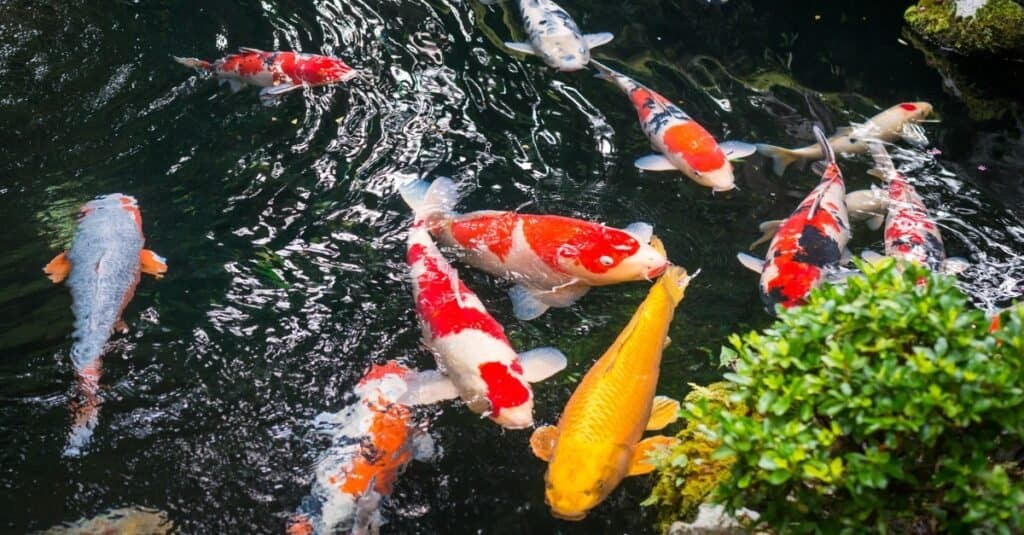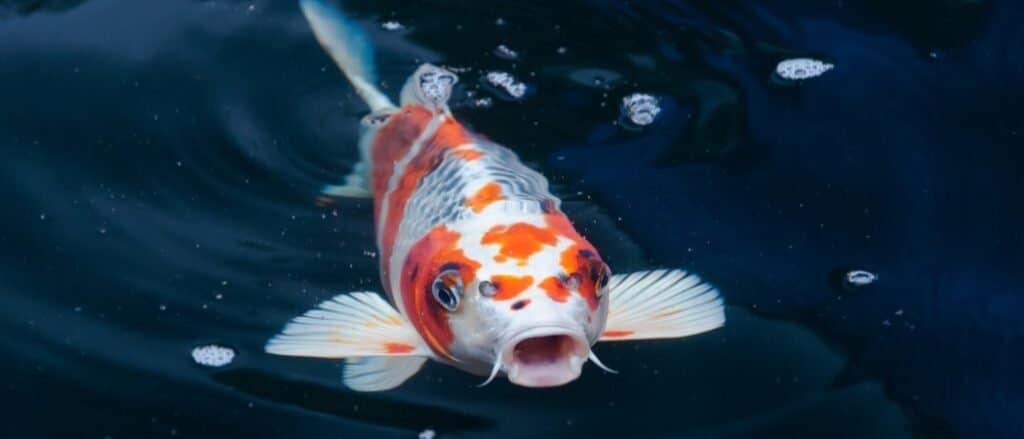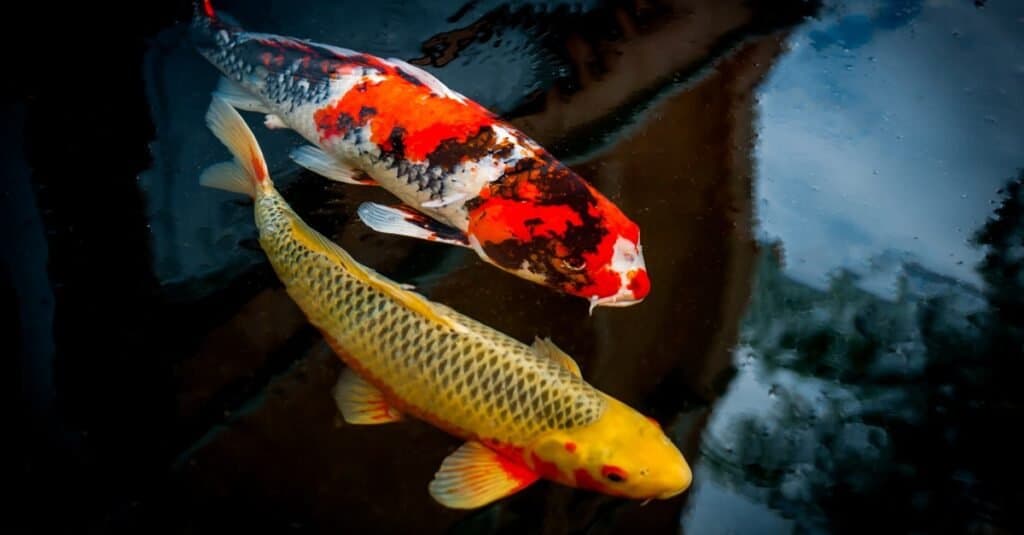Nishikigoi, better known as koi fish, are a well-known variety of the common carp. They feature an appealing bright white and red color combination that sets them apart from the crowd. Even other animals – including their predators – are drawn to their beauty.
Besides their dashing looks, koi are popular for being strong, intelligent, and resilient creatures whose lifespan ranges between 25 and 40 years. However, they can sometimes live far longer. For example, Hanako, the oldest representative of this species and a native to Japan died when she was 226 years old!
Moreover, many pet owners like koi because of their gentle and friendly nature. But here’s a piece of even more interesting news—most types of koi are worth hundreds of thousands of dollars. And some have even fetched almost $2 million!
Itching to know the most expensive koi ever sold? Read on to learn valuable and intriguing details about these fascinating fish.
Which is the Most Expensive Koi Fish Ever Sold?
The most expensive koi in history was S Legend, a Kōhaku variety that brought in a whopping $1.8 million (203 million Yen) in October 2018. Miss Yingying, a koi enthusiast and collector, bought the female 39-inch colorful carp from the popular breeder Kentaro Sakai, after an intense bidding war in Hiroshima at his fish farm.
Some people couldn’t grasp why Miss Yingying decided to part with such a huge amount when some Kōhaku koi cost as little as $50. But the answer was pretty clear—S Legend was a great investment. For starters, the particular fish species can lay up to 100,000 eggs during one breeding season. Even if only 1% matches the required quality, that’s plenty of baby Kōhaku to help her recoup her investment. In addition, Kōhaku koi can grow up to 50 inches, and their value increases with size.
Unfortunately, multiple sources reveal S Legend died in 2019.
Different Varieties

The many varieties of koi boast distinctive features that help you to tell them apart.
©M_MUC1968/Shutterstock.com
There are various types of Kōhaku koi today, including:
- Dangara
- Akamuji
- Odome
- Makibara
- Komoyō
- Kuchibeni
- Shiromuji
- Ōmoyō
- Zubonhaki
These varieties boast distinctive features that help you to tell them apart. For instance, Shiromuji is entirely white, but Makibara features a hi (red) around their bellies. Dangara is among the most preferred Kōhaku subspecies. Their pattern comprises perfectly separated white and red markings that resemble a pool’s steppingstones.
All Kōhaku Koi Aren’t Worth the Same Amount of Money
Although Kōhaku koi are generally expensive, these fish have different price tags based on their physical attributes. The most valuable ones have a bright white (the sashi) at their tails and pectoral and dorsal fins.
The value of a Kōhaku koi fish decreases if its sashi is thin or looks greyish. Some less valuable subspecies are Komoyō, Makibara, Kuchibeni, and Shiromuji. On the other hand, Dangara is preferred and valued because of its distinctive pattern.
Furthermore, Kōhaku koi with tiny speckles of red are inexpensive, and the same applies to those whose fins or tails have the hi.
Gender and Age Affect Coloration
More often than not, the colors of Kōhaku koi depend on their sex and age. For instance, male species develop their hi during their early stages, but the red tends to fade as they age. On the contrary, female koi fish take more time to attain their red coloration, and they retain it even as they grow older.
If coloration is among the features you consider when getting a Kōhaku koi, factor in the age and gender of the fish before making your purchase. However, these physical attributes shouldn’t matter if you’re not buying the marine creatures to resell or exhibit at shows.
It’s also worth mentioning that diet impacts the Kōhaku koi’s capability to develop and retain a healthy coloration. You could invest in one with a weak hi, and feed it food with color enhancers to attain a bright shade of red. Ideally, their diets should contain plenty of proteins, spirulina, and krill to achieve the best results.
Other Expensive Types of Koi Fish
Apart from Kōhaku, other koi fish varieties have been sold for hefty sums. These include:
Taisho Sanshoku – $341,990
Also known as Sanke or Taisho Sanke, this koi fish is high-priced because of its ancient origins. It was first developed in 1918 during the era of emperor Taishō, which is why it was named after him. Unlike some varieties, it has sumi (black) scattered over its body, meaning it has three colors instead of only red and white.
Besides its long lineage, the unique color pattern of Taisho Sanshoku koi contribute to its high value. The most expensive one, a Maruten Sanke, fetched 41 million Yen ($341,990) at a Sakai Fish Farm auction in 2015. In 2013, another spectacular Taisho Sanke (Shining Rose) fetched 21 million Yen ($213,223) at the same location.
Showa Sanshoku – $68,000
In 2014, Ryuki Narita of Narita Koi Farms purchased a Showa Sanshoku koi for 7 million Yen ($68,000) from the 6th Dainichi Koi Farm annual auction. Like the Sanke, this variety has its share of sumi; its body is black, with white and red patches.
Lineage is the main reason the Showa Sanshoku is costly and popular. The breeder Jukichi Hoshin first developed it in 1927 by matching a Ki-Utsuri and a Kohaku. Back then, the sashi was grayish, the hi was weak, and the sumi was faded. In 1964, another breeder, Tomiji Kobayashi, paired a female Showa with a male Kohaku, but the result was too small and had a weird body shape. Only the combination of an Inazuma Showa and Minoru Mano produced a desirable breed with good color quality and size.
Tancho Kōhaku – $17,000
The Tancho Kōhaku is a popular koi variety bred from different types of Nishikigoi, such as Showa Sanshoku, Taisho Sankshoku, and Kōhaku. Its most distinguishing characteristic is the bright red patch on its head. Since the rest of its body is white, it resembles the flag of Japan, explaining why the country’s nationals adore it.
Intriguingly, the Tancho Kōhaku’s unique color pattern is not a fluke. It took breeders centuries to achieve it, and some still have difficulty attaining it, which bumps up its price. The most expensive specimen sold for $17,000. However, some have an orange coloration near the red circle on their heads and are worth less than $2,000.
Doitsu – $16,000
The Doitsu is a unique fish variety you can put in your pond if you like koi. Thanks to selective breeding and an FGFR1 gene mutation, it lacks scales, so its skin is smooth. Decades ago, this aspect made preparing it easy, and many people relished eating it. Others were captivated by its abnormality and kept it as a pet.
Doitsu koi have been around for more than a century. Since they’re also rare, they can cost up to $16,000, especially if they have attractive colorations, including black, white, and red. Because their gene mutation is hereditary, some koi enthusiasts invest in them for breeding purposes.
Still, various koi farms sell Doitsu for as low as $400, and younger fish can be priced at only $10. Before making your purchase, consider its skin—it should be bright without any blemishes or discoloration. The creature should also have a uniform, torpedo-shaped body, and a round head.
Kumonryu – $15,000
The Kumonryu is a striking black and white, scaleless fish, which most people call the flying dragon of koi. But that’s not the only feature that makes it unique. During various times of the year, its skin changes from black to white.
Getting a baby Kumonryu off the market can be tricky because they change their patterns so often that identifying them is difficult. If you want to land a good one, buy two or three specimens, especially if you can care for them comfortably.
Unfortunately, Kumonryu isn’t pocket-friendly because just one can sell for $15,000.
Shiro Utsuri – $10,000
The Shiro Utsuri is a small type of koi that costs up to $10,000. With its balanced black and white pattern, it looks like a dalmatian or Holstein Friesian, explaining why it’s pricey. Most fish are 35 inches long, but you could develop one with a length of 39 inches through selective breeding.
As many koi keepers can attest, finding a good Shiro Utsuri specimen can be challenging. It takes many years for this fish to mature and might undergo unexpected and undesirable changes. For example, because this fish is a black-based species, the sumi may develop in places you won’t like, making it too dark.
Why Koi Fish are Sought-After

Koi represent patience and perseverance. They’ve been around for years, overcoming countless challenges, while other animals have gone extinct.
©PokkO/Shutterstock.com
Despite being big-budget species, most people covet koi fish because of what they signify. To begin with, these creatures are symbols of abundance and good luck in the Japanese culture since they can defy the odds to grow incredibly large and live longer than expected. They also have a calming influence as they swim leisurely in the water without bothering other fish.
In addition, koi represent patience and perseverance. They’ve been around for centuries, overcoming countless challenges, while other animals with ancient histories have gone extinct.
In Japan, many varieties of koi have different significance based on their color patterns and other physical features like finnage. For example, the red and white Kōhaku symbolizes love and a lucrative career. On the contrary, the longfin koi represent harmony and class.
Useful Tips to Move Koi Fish
If you have little experience, you might wonder how to safely move your koi fish from one pond to another. Luckily, it’s straightforward, especially if you leverage these tips:
Net Your Koi Properly
Learn how to net your koi properly as you prepare it for the move. Ideally, you should place the netting in front of the fish as you gently persuade it to enter. Chances are, it will swim around it. Still, don’t pursue it, as that only stresses the fish, which increases its chances of falling ill during travel. Once the koi is in the net, be careful because it might try to escape.
Put It in the Right Container or Bag
You’ll need a secure rigid container to move your koi fish. Of course, you must put the animals in bags before placing them in the vessel. You can use the plastic bags alone as long as you seal them with some quality rubber bands.
Also, putting the koi’s original pond water in the bags you plan to use to relocate them is important. It makes them feel like they’re in their normal environment, which alleviates stress. Additionally, fill the pouches with pure oxygen because the fish need it to aid their metabolic processes.
Avoid Feeding the Koi for a Week
You should feed koi fish daily to provide them with enough nutrients. However, if you contemplate moving them, don’t feed them for a week to slow their metabolism and prevent them from pooping or urinating in the water during transportation.
Keep Them Cool
Keep koi fish in a cool environment when moving them to prevent overheating, which forces them use their oxygen too quickly. Transporting the animals in your car is an excellent way to do that. If you’re leveraging air travel, place an ice pack in the container you put the bags in.
Interesting Facts about Koi Fish

Koi fish are omnivores that enjoy many types of foods, including watermelon!
©tonirichsag1411/Shutterstock.com
Here are some intriguing facts you might not know about the revered koi fish:
- Koi fish originated in China in the 4th century.
- The world’s largest koi fish was 48 inches long and weighed 41.2 kilograms.
- Initially, koi fish were bred in Japan to increase the country’s food supply.
- Goldfish and koi fish are relatives, though the former has been around longer.
- Koi fish are omnivores that enjoy many types of foods, including watermelon!
- Koi fish have pharyngeal teeth at the back of their throats.
- There are over 20 koi fish varieties, such as Kohaku, Soragoi, Kumonryu, Hi Utsuri, Shusui, Matsuba, and Showa Sanshoku.
- Most koi fish outlive their owners and are passed on or sold to other people.
- Koi fish are surprisingly sharp-witted and can be trained like dogs and cats!
- Koi recognize the person who cares for them.
- Koi fish enjoy each other’s company.
Valuable Types of Koi Fish
Most people buy koi fish because of their unmatched beauty. Of course, you can invest in them for business purposes, but that requires prioritizing aspects such as coloration and size that affect the price.
Rarity is another factor determining this fish species’ cost—rarer varieties like solid-colored koi are worth more than commonplace forms with red and white color patterns. Koi’s origin also helps to determine their price. For example, fish born in Japan are costlier than those bred in the United States and other parts of the world.
If you collect koi to resell them, dig deeper to know their history and understand their distinctive features. This prevents some buyers from shortchanging you, knowingly or otherwise.
Also, giving your koi the best care should be a priority, whether you’re keeping them for their good looks or profit. Thankfully, it’s undemanding; create a safe, suitable environment in your pond or aquarium, feed them at least once a day, and monitor them regularly to confirm they’re healthy.
This should have your koi looking beautiful and fetching higher prices if you decide to sell them. Investing in koi fish requires work, but it’s an enriching endeavor. Learning about koi and taking care of them will ensure you get the most out of them—financially or otherwise.
The photo featured at the top of this post is © glory_yabe/Shutterstock.com
Thank you for reading! Have some feedback for us? Contact the AZ Animals editorial team.





